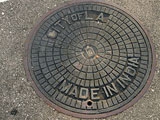Riding the EU-India Drift
By Harsh V Pant for ISN
A few days back, India and the EU celebrated a decade of bilateral summitry with a great deal of pomp and circumstance, reaffirming their ‘strategic partnership’ and underlining their shared values of democracy, human rights, pluralism, rule of law and multilateralism. Yet the substantive outcome was merely a civilian nuclear energy cooperation pact in the mould of the landmark US-India nuclear deal finalized last year.
Though India was among the first countries to establish diplomatic relations with the European Economic Community, it was only in 2004 that the EU formalized ties with India into a ‘strategic partnership.’ This was seen as very significant as the EU has strategic partnerships with only five other countries - the US, Canada, Russia, Japan and China.
Bilateral ties have grown considerably since 2004. The EU's gradual gravitation toward India is also the result of a growing unease with China's economic dominance. Not only is India seen as a better enforcer of intellectual property rights laws, but diversification also seems to be a better strategy for Europe. While China is not seen as being fully integrated into the international system, India, being a liberal democracy, is considered almost a fellow traveler.
India has been a major beneficiary of the EU's Generalized System of Preferences scheme that provides duty reduction, and duty free and quota free access to products from developing and least developing countries. The EU is India's largest trading partner and one of its largest sources of foreign direct investment.
It is hoped that in the coming years, India and the EU will explore the possibility of implementing a coordinated call for climate change research so that experts on both sides can work on collaborative research projects.
Despite the well-intentioned attempts by the EU to engage India more productively in recent years, there are significant constraints that continue to limit these ties from reaching their full potential. For long, the EU had single-mindedly focused on China, ignoring the rise of India in the Asia-Pacific. India's rising economic profile, US overtures to India, and its growing role on the global stage from the UN to the World Trade Organization, all have forced the EU to make it one of its strategic partners.
The EU has been lukewarm at best to support India's bid for a permanent membership in the UN Security Council. This is partly because different member states have different views on this issue and partly because the EU is still testing the waters to see which way the wind will ultimately blow .
The EU and India also find themselves on the opposite sides in trade negotiations in the WTO, and there are strong differences over the EU's farm subsidy policy and on issues related to market access. The EU's reluctance to reduce the massive agricultural subsidies to its farmers that distort fair competition in agricultural trade continues to be a major bone of contention between the EU and India. India is a member of the G-20 and G-33 groupings of developing countries resisting the agenda of the developed world in the WTO.
Though the EU is India's largest trading partner, its economic ties with India are yet to achieve their full potential with total FDI into the country still amounting to only 1 percent of EU outflows and being less than one-tenth of that into China. Despite seven rounds of negotiations, a free trade agreement between India and the EU has failed to become a reality.
Finally, and perhaps most important, there is the issue of the EU mindset which still views India as a regional South Asian power and continues to equate India with Pakistan. Despite some belated efforts, the EU continues to see security issues through the old lens, trying to find a fine balance between New Delhi and Islamabad. Unlike Washington, which has for some years now been viewed India as a ‘major pole’ in an emerging multipolar global order and a ‘balancer’ in the Asia-Pacific strategic landscape, Brussels has been unable to articulate what role it sees for India in the emerging security architecture.
With the exception of France and Britain, other member-states of the EU were not entirely supportive of the US-India nuclear deal as was clear from the initial deadlock at the Nuclear Suppliers Group. This granting of an extraordinary exception to India by the US did not go down well with the nonproliferation constituencies in various EU countries. It is indeed ironical that a year on the EU was forced to follow the US and conclude a similar a similar deal with India for fear of losing that lucrative market.
As the center of gravity of global politics and economics shifts to Asia-Pacific and the international system undergoes a profound re-ordering, the EU is trying hard to adapt to these new global realities. While trade and economics seems to have given the EU a reference point vis-à-vis the China and India, politically it seems adrift. Europe’s inability to formulate a coherent foreign policy across the EU nations has made it difficult for it to respond as effectively to the rise of China and India as it would like to.

